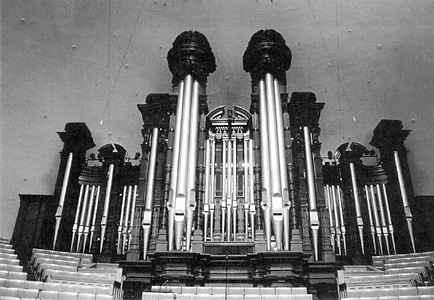
Tabernacle Organ |

A widely recognized Mormon landmark, the Tabernacle Organ is one of the largest and finest in the world. It was originally built by Mormon pioneer Joseph Ridges for the newly completed Salt Lake Tabernacle in 1867. It was rebuilt 5 times over the next 124 years (shown here after the 1916 expansion). The current organ consists of 11,623 speaking pipes, ranging in length from 3/4 inch to 32 feet.
by Jack M. Bethards
While not the world's largest, the organ in the Salt Lake tabernacle is one of the most famous musical instruments ever produced. Thanks to the widely disseminated "Music and the Spoken Word" weekly radio (and later TV) broadcast, this organ has probably been heard by more people than any other. Year-round daily recitals (inaugurated in 1915 and attended by millions of visitors to Temple Square each year) and numerous performances at Church conferences and other public recitals and concerts add to the number of people whose lives have been enriched by this remarkable instrument.
The present organ was built in 1948 by the Aeolian-Skinner Company of Boston, under the supervision of its president and tonal director, G. Donald Harrison. However, the person most responsible for the project was Tabernacle organist Alexander Schreiner, who, with colleagues Frank Asper and Roy Darley, shared the goal of creating an organ for Temple Square to equal the greatest ever known. Given the enthusiastic acceptance of this instrument by organ experts and the general public, they did indeed succeed.
This organ is the most recent of a line of fine Tabernacle instruments. Pioneer organ builder Joseph Ridges (1827-1914) installed the first one in 1867. Some pipes and parts from that organ and its successors have been incorporated into the present instrument not only to provide a link with the past but also to preserve the superb quality of those artifacts. The most notable feature from pioneer days is the central portion of the large organ case. The famous golden pipes, made of wood staves fashioned from Utah timber, still play today. Over the years, the case has been enlarged, but always following the style of the original, which was influenced by the Boston Music Hall organ (Walcker, 1863), the most sensational instrument of its day.
Neils Johnson enlarged the organ in 1885. Then an instrument incorporating some of the pioneer pipes and parts was built by the Kimball Company at the turn of the century. Much of that organ was replaced by the Austin Company in 1915. Essentially this is the instrument that was heard on the first radio broadcasts from the Tabernacle in 1930.
Most organ historians consider the present organ to be the most complete and perfect example of the American Classic style. The prime mover in developing the American Classic organ was G. Donald Harrison, who brought this concept to maturity after World War II. Alexander Schreiner was impressed with this forward-looking approach and felt that an all-American instrument drawing on European and English traditions would be appropriate for the Tabernacle.
The organ presently contains 11,623 individual pipes organized into 147 voices (tone colors) and 206 ranks (rows of pipes). Grouped into 8 divisions, they are controlled from a console with five 61-note manuals (keyboards) and a 32-note pedalboard. All divisions of the organ are located behind the massive casework on the west end of the Tabernacle except the antiphonal division, which is in the lower attic at the east end and speaks through openings behind the center balcony seats. The longest pipe is 32 feet in speaking length; the shortest is three-quarters of an inch. Pipes are made of wood, zinc, and various alloys of tin and lead.
Between 1985 and 1989, Schoenstein and Co. of San Francisco directed a major renovation of the organ, regulating all pipework, rebuilding the console, and installing seventeen ranks of new pipes.
[See Daily Living home page; Attitudes Towards the Arts home page.]
Bibliography
Bethards, Jack M. "The Tabernacle Letters." The Diapason (June 1990):14-17; (July 1990):8-9; (Aug. 1990):10-11.
Callahan, Charles. The American Classic Organ: A History in Letters. The Organ Historical Society, Richmond, Virginia, 1989.
Owen, Barbara. The Mormon Tabernacle Organ: An American Classic. Salt Lake City, 1990.
Encyclopedia of Mormonism
Copyright © 1992 by Macmillan Publishing Company
All About Mormons |